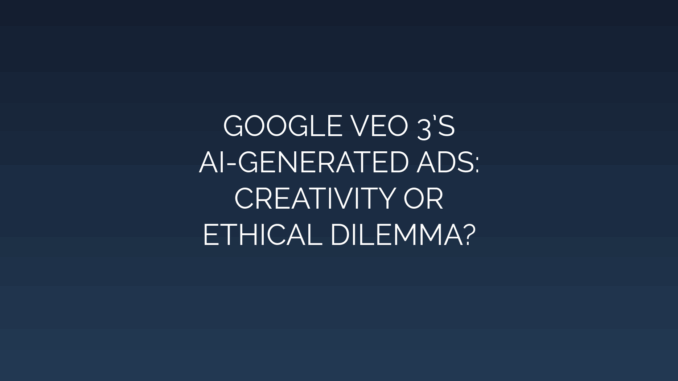
Google Veo 3’s AI-Generated Ads: Creativity or Ethical Dilemma?
The advertising landscape is undergoing a seismic shift with the emergence of AIgenerated content tools like Google Veo 3, an advanced video synthesis model capable of creating polished, professional advertisements in seconds. By simply inputting text prompts, marketers can generate tailored videos—complete with scenes, voiceovers, and music—without traditional production crews. While proponents herald this as a democratization of creativity, critics warn of profound ethical risks. The central question emerges: Does Veo 3 represent an innovative leap in advertising, or does it herald a new era of ethical quandaries?
What is Google Veo 3?
Google Veo 3 is a generative AI model focused on video creation, building on its predecessor’s capabilities. It uses neural networks to transform text descriptions into dynamic video sequences, simulating humanlike cinematography. Key features include:
- Scene Generation: Creates realistic backgrounds, characters, and actions from prompts (e.g., “a person running through a futuristic city at dusk”).
- Dynamic Editing: Auto-generates cuts, transitions, and pacing adjustments.
- Multimodal Integration: Syncs voiceovers, music, and visuals using AI-synthesized elements.
- Speed & Scalability: Produces ad variations in minutes, bypassing weeks of production.
This technology promises hyperpersonalized campaigns, rapid A/B testing, and dramatic cost reductions, empowering small businesses and Fortune 500 companies alike.
The Creative Renaissance
Veo 3’s supporters champion its potential to revolutionize creativity. Traditional ad production involves laborintensive workflows—scripting, casting, location scouting, and editing—often gatekept by budget constraints. Generative AI disrupts this:
- Democratization: Startups gain access to high-quality video ads previously unaffordable at scale.
- Experimentation: Marketers iterate rapidly, testing 50+ ad variants overnight to optimize engagement.
- Personalization: Ads adapt geographies, cultural nuances, or context in real-time (e.g., a coffee ad showing rain for London users versus sunshine in L.A.).
Brands like Muve Health and Lotte Shopping report 40% faster campaign deployment using generative AI, enabling agile responses to market trends. For creative teams, Veo 3 becomes a “copilot,” automating repetitive tasks and freeing time for strategic storytelling.
The Ethical Minefield
Despite its promise, Veo 3 amplifies ethical concerns at multiple levels. These issues challenge not just fairness but the fundamental integrity of digital content:
Intellectual Property And Originality
- Unlicensed Synthesis: Veo 3 trains on vast datasets. Content generated using copyrighted visuals, music, or artist styles could infringe rights without compensation.
- Creative Homogenization: If all brands leverage similar AI templates, advertising risks losing authentic “human” differentiation.
Misinformation And Fraud
- Deepfakes: Realistic, AI-generated actor replacements can spread disinformation or impersonate celebrities—a legal grey area in advertising.
- Algorithmic Bias: Veo 3 could propagate stereotypes if training data is uncurated (e.g., gender roles in home products ads).
Workforce And Economic Impacts
- Job Displacement: Roles like cinematographers and editors face obsolescence as generative AI handles core production tasks.
- Economic Concentration: Dominant AI tools may widen the gap between tech giants and smaller creators.
Transparency Gaps
- Undisclosed AI content blurs human-AI boundaries, eroding consumer trust. Regulatory bodies lack frameworks for mandatory labeling.
Case Studies: Innovation vs. Controversy
- Empowering SMBs: An independent watchmaker used Veo 3 to create cinematic campaigns for less than $1,000 (vs. $30K traditionally), boosting sales by 70%—a testament to accessibility.
- Backlash Scenario: A health brand faced outcry when consumers discovered its “authentic” testimonial video featured an AI avatar emulating a real illness-survivor’s likeness without consent.
Balancing Creativity and Ethics
Resolving Veo 3’s dualities requires proactive measures across stakeholders:
Industry SelfRegulation
- Clear Attribution: Google should enforce visible labels (e.g., “AI-generated”) in Veo 3 outputs.
- Ethical Training: Auditing training data for bias and copyright compliance.
Policy Intervention
- Legislation: Laws like the EU AI Act mandate transparency for generative AI in advertising. Similar U.S. bills aim to criminalize non-consensual deepfake ads.
- Copyright Reform: Adjusting “fair use” doctrines to protect creators whose work trains models like Veo 3.
HumanCentric Adaptation Brands must prioritize disclosing AI use and preserve “human oversight layers”: 1. Creatives remain curators: Using AI for ideation but human edits for originality. 2. Consent safeguards: Banning synthetic personas resembling real people without permission. 3. Ethical audits: Reviewing outputs for biases and deception prepublication.
The Future of AI Advertising
Veo 3 signals an inevitable trajectory: nearly 80% of marketers expect generative AI to manage creative workflows by 2030. Future iterations could simulate complex narratives or influencer avatars indistinguishable from reality. Yet, this amplifies stakes. Imagine an ad ecosystem dominated by synthetic personas, where authentic human artistry becomes a luxury premium. Conversely, AI could elevate equity—imagine nonprofits generating compelling campaigns at nearzero cost.
The path forward demands rigorous safeguards anchored in three pillars:
- Transparency: Unambiguous labeling of AI-generated content.
- Accountability: Legal frameworks for attribution, consent, and bias.
- Innovation Ethics: Using generative AI as a collaborative booster, not a replacement.
Conclusion
Google Veo 3 encapsulates advertising’s generative AI paradox. Its ability to unleash creativity—democratizing access and accelerating innovation—is undeniable. Yet, unchecked automation risks ethical erosion: plagiarism traps, deception crises, and socioeconomic inequity. The technology itself is neutral, but its deployment is not. Success hinges on navigating the tension between efficiency and integrity. Companies should adopt frameworks that place human judgment first—treating Veo 3 not as an autopilot, but as a tool constrained by conscience. In this balance, creativity thrives without compromising ethical imperatives. Should the industry fail, Veo 3 could become synonymous with a trust deficit; should it succeed, it marks the dawn of a responsible creative renaissance.
Leave a Reply